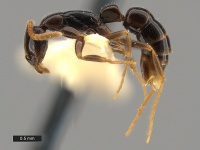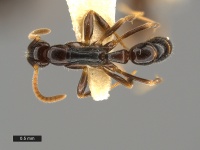Leptogenys sagaris
This species is known from rainforest leaf litter and nests under objects on the ground. It appears to be timid when its nest is opened.
| Leptogenys sagaris | |
|---|---|

| |
| Scientific classification | |
| Kingdom: | Animalia |
| Phylum: | Arthropoda |
| Class: | Insecta |
| Order: | Hymenoptera |
| Family: | Formicidae |
| Subfamily: | Ponerinae |
| Tribe: | Ponerini |
| Genus: | Leptogenys |
| Species: | L. sagaris |
| Binomial name | |
| Leptogenys sagaris Wilson, 1958 | |
Identification
Diagnosis (worker). Closely resembling Leptogenys anitae Forel of Queensland, differing principally in the following characters:
(1) Distincly smaller in size. Head width of sagaris types 0.64-0.69 mm; head width in two nest series of anitae examined not less than 0.82 mm.
(2) Eyes proportionately smaller in size. In sagaris there are only five to six ommatidia along the maximum length of the eye, while in anitae there are approximately twelve to sixteen ommatidia along the same line of measurement.
(3) Petiolar node proportionately shorter in sagaris. The above diagnosis will also serve to distinguish L. sagaris from its nearest Melanesian relative, Leptogenys bituberculata Emery. The latter species is further distinguished from both sagaris and anitae by the following characters: body pilosity proportionately longer; head tapering more posteriorly when viewed in full face; dorsal border of petiolar node viewed from the side descending more abruptly in an anterior direction.
Keys including this Species
Distribution
Latitudinal Distribution Pattern
Latitudinal Range: -21.533333° to -22.233333°.
| North Temperate |
North Subtropical |
Tropical | South Subtropical |
South Temperate |
- Source: AntMaps
Distribution based on Regional Taxon Lists
Australasian Region: New Caledonia (type locality).
Distribution based on AntMaps
Distribution based on AntWeb specimens
Check data from AntWeb
Countries Occupied
| Number of countries occupied by this species based on AntWiki Regional Taxon Lists. In general, fewer countries occupied indicates a narrower range, while more countries indicates a more widespread species. |

|
Estimated Abundance
| Relative abundance based on number of AntMaps records per species (this species within the purple bar). Fewer records (to the left) indicates a less abundant/encountered species while more records (to the right) indicates more abundant/encountered species. |

|
Biology
Accession no. 240 consisted of a colony found nesting under a rock on the floor of the Fere woodlot. It contained an estimated 50-75 adult workers. The holotype nest series (no. 272) was taken from a colony nesting in a small rotting log buried in leaf litter in the Canala River forest. It contained an ergatogyne and an undertermined number of workers. As in the related species Leptogenys bituberculata and Leptogenys hebrideana, the workers of sagaris are relatively timid and fast, and scatter quickly when the nest is opened.
Castes
Ergatogynes are present. Normal queens have not been found.
Nomenclature
The following information is derived from Barry Bolton's Online Catalogue of the Ants of the World.
- sagaris. Leptogenys sagaris Wilson, 1958a: 137, fig. 5 (w.) NEW CALEDONIA.
Description
Holotype worker. HW 0.67 mm, HL 0.97 mm, SL 0.83 mm, CI 69, SI 124, EL 0.12 mm, PW 0.53 mm, petiolar node height 0.69 mm, petiolar node length 0.56 mm, dorsal petiole width 0.35 mm.
Paratype worker variation. HW 0.64-0.69 mm (encompassed by a single nest series, acc. no. 240). The paratype series shows very little variation in external morphology.
Ergatogyne. HW 0.64 mm, HL 0.89 mm, SL 0.73 mm, CI 72, SI 114, EL 0.12 mm, PW 0.48 mm, petiolar node height 0.41 mm, petiolar node length 0.38 mm, dorsal petiolle width 0.40 mm. The single individual examined (acc. no. 272) is very worker-like. The head is very simmilar to that of a small worker, lacking ocelli and showing no enlargement of the compound eyes. The alitrunk is smaller proportionate to the head than in the worker. A distinct metanotal groove is present which is lacking in the worker. The petiolar node is much shorter and broader than in the worker; seen from the side it approximates an isosceles triangle in outline, with a broadly rounded dorsal border. The gaster is large, its volume exceeding by 1.5 X that of a large worker.
Material examined. NEW CALEDONIA: Ciu, 300 m.; holotype nest series, Wilson acc. no. 272, one ergatogyne and 9 workers; acc. no. 230, one worker; acc. no. 240, 9 workers. Chapeau Gendarme, one worker.
References
Wilson, E. O. 1958c. Studies on the ant fauna of Melanesia. I. The tribe Leptogenyini. II. The tribes Amblyoponini and Platythyreini. Bulletin of the Museum of Comparative Zoology 118: 101-153 (page 137, fig. 5 worker described)
References based on Global Ant Biodiversity Informatics
- Jennings J. T., L. Krogmann, and C. Burwell. 2013. Review of the hymenopteran fauna of New Caledonia with a checklist of species. Zootaxa 3736(1): 1-53.
- Ramage T., C. Jouault, A. R. Schmidt, L. J. Seyfullah, and V. Perrichot. 2019. Two new ant species (Formicidae: Dorylinae, Ponerinae) from New Caledonia. European Journal of Taxonomy 589: 1-14.
- Taylor R. W. 1987. A checklist of the ants of Australia, New Caledonia and New Zealand (Hymenoptera: Formicidae). CSIRO (Commonwealth Scientific and Industrial Research Organization) Division of Entomology Report 41: 1-92.
- Wilson E. O. 1958. Studies on the ant fauna of Melanesia. I. The tribe Leptogenyini. II. The tribes Amblyoponini and Platythyreini. Bulletin of the Museum of Comparative Zoology 118: 101-153.


